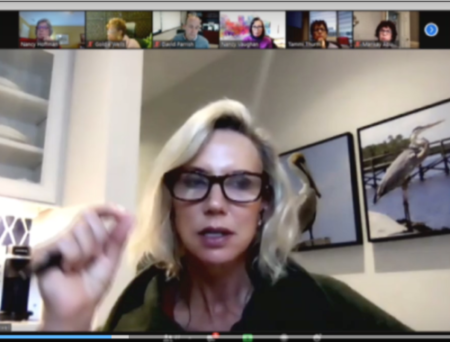The Greensboro City Council spent some time discussing violent crime statistics at the virtual retreat on Friday, Feb. 12.
The City Council did not discuss what could be done to stop the increase in violent crime or what it had done in the past year to try and decrease violent crime.
The strategic goal the City Council set in 2020 was to reduce violent crime by 20 percent by 2022. At the time, the discussion centered around reducing violent crime by 20 percent in two years, or 10 percent a year.
However, violent crime in 2021 increased by 11 percent and homicides increased by 36 percent.
Mayor Nancy Vaughan offered a solution. She said, “Are we using as benchmark last year’s number or this year’s number?”
Councilmember Justin Outling said, “I’m not in favor of actually changing the goal. The baseline is what we said at the annual retreat. Otherwise we are changing the goal.”
Vaughan tried several times to get support for changing the goal to the current year but only got support from Councilmember Michelle Kennedy. With violent crime up 11 percent in 2020, it would be easier to start over and try to reduce violent crime by 20 percent from the 2020 number with 61 homicides than the 2019 number with 45 homicides. Resetting the goal would also give the City Council an additional year in which to achieve the 20 percent goal.
With little support for changing the goal, Vaughan later said that was not her intent.
The council also discussed changing from a calendar year to the fiscal year. The calendar year begins on Jan. 1 and is the traditional way crime statistics are kept. The fiscal year begins on July 1 and might allow the City Council some more wiggle room, but that did not gain support either.
Councilmember Marikay Abuzuaiter said, “I don’t think we can attain 20 percent by 2022.” She later asked what a realistic goal would be.
The strategic consultant, Meredith Powell, said that it was rare for her to recommend a goal that wasn’t achievable but that setting goals was “part marketing and communication and I do believe that you’re communicating to the public and I do think it would send the wrong message to lower that goal.”
What the City Council finally agreed to do is to include all the separate categories of violent crime, although they were unsure what they were. However, both rape and robberies were down in 2020. So, the new goal is to reduce each violent crime category by 20 percent by 2022.
Councilmember Tammi Thurm said, “I like putting 20 percent from 2019 levels by 2022 in each of the four categories.”
The council appeared to reach consensus on that as the revised goal.
So, the goal is the same except instead of violent crime overall it is reducing violent crime in each category.
The crime rate in each of those categories from 2019 to 2020 is: homicides increased by 36 percent, rape decreased by 16 percent, aggravated assaults increased by 18 percent, and robbery decreased by 6 percent.


They can twist the numbers however they wish, it won’t make any difference until the council acknowledges they cannot change anything without the Police and the communities they serve fully involved.
This must be the same math that the Federal and State statistics keepers use for Covid 19 numbers.
And if the crime rate decreases by one percent these Council members are going to take credit for it ain’t they? There are more to improving a City then making “GOALS” and more GOALS and more GOALS. That seems to be ALL that they are taking about. “GOALS”!!! What a joke!!! And a waist of time.
Absolutely the most inept city council that has met in those chambers ever for Greensboro and probably in the state. If they cannot throw some of our money at a problem, then they are at a impasse as to their next move. It saddens me to know that this is what we have, attempting to grow and protect this great city, that I have been a part of off and on since 1964. We , the citizens , have shot ourselves on purpose directly in our foot.
How aboput setting a target of ZERO violent crime and holding themselves accountable.
Better yet, how about the ENTIRE Council resigning for the abysmal record they own to date?
They can set all of the goals they want, but if they do nothing to reach those goals, then it is all for naught. Thus far, they have set goals, and then sat back and waited to see if the crime rate fixed itself.
Gosh, if only the had paid the “Cure Violence” group a whole million dollars! Maybe crime would have only risen by 10% and homicides by 30%…boondoggle!
What can we do to reduce the crime issues?
A. Rookies and cookies
B. Coffee with Cops
C. Rainbows and unicorns
Oh wait… Here’s a crazy idea…
How about we start ENFORCING the law again?